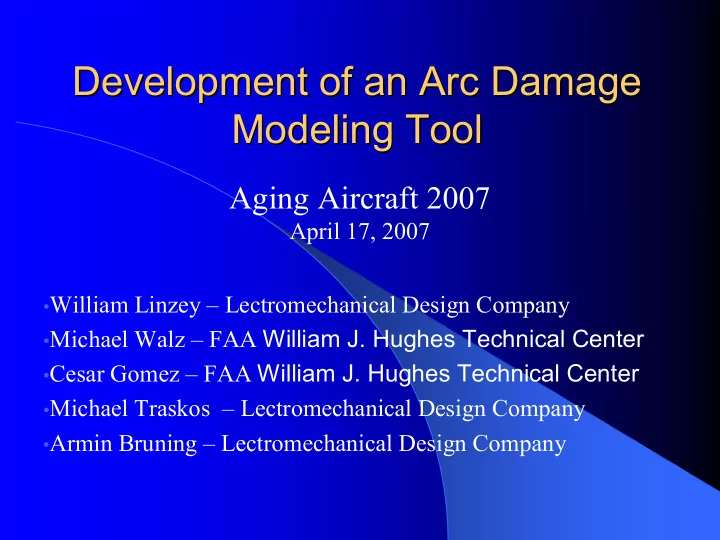

Development of an Arc Damage Development of an Arc Damage Modeling Tool Modeling Tool Aging Aircraft 2007 April 17, 2007 • William Linzey – Lectromechanical Design Company • Michael Walz – FAA William J. Hughes Technical Center • Cesar Gomez – FAA William J. Hughes Technical Center • Michael Traskos – Lectromechanical Design Company • Armin Bruning – Lectromechanical Design Company
Examples of Arcing Damage Examples of Arcing Damage
Goal of the Program Goal of the Program � Modeling tool that can represent damage incurred from an arcing event. � Data produced from the tool can be used to support TC and STC applications. � Supported by the FAA William J. Hughes Technical Center
Program Outline Program Outline 2 year effort that began January 2007 � Effort is divided into 4 Tasks � 1. Generation of Empirical Data 2. Development of Analytical Methods 3. Development of the Modeling Tool 4. Demonstration Kit and Presentation
Types of Damage to be Modeled Types of Damage to be Modeled � Target (What is arced to) � Other Wires in the bundle � Objects at a distance – Ejected Metal – Hot Ionize Gas Plume
Mitigation Techniques to be Considered Mitigation Techniques to be Considered � Arc Fault Circuit Interruption (AFCI) � Separation and Segregation � Non Arctracking Wire Insulation
Test Parameters Test Parameters � Initiation Method � Source Voltage � Fault Current � Arcing Duration (Circuit Protection) � Wire Gauge & Insulation Type � Number of Power Wires � Target Material & Geometry
Initiation Methods Initiation Methods � Swing Test � Vibration � Guillotine � Wet Arcing
Target Material & Geometry Target Material & Geometry � Hydraulic Line: Aluminum � Hydraulic Line: Titanium � Flight Control Cable: Steel � Aircraft Structure: Aluminum � Possible: Pressurized Hydraulic Line
Parts of the Model Parts of the Model � Modeling the arc – Power – Duration of the arc � Partition of energy – Incident on Target – Dissipated into the Source (Wires) – Ejected from Arcing Area ( Hot Gas & Ejected Material) � Damage – Arc Energy Heating Metallic Target – Hot Gas Heating Wire Insulation
Example: Damage to Hydraulic Line Example: Damage to Hydraulic Line Movie Movie
Example: Damage to Hydraulic Line Example: Damage to Hydraulic Line Photo Photo
Example: Damage to Hydraulic Line Example: Damage to Hydraulic Line Voltage and Current Waveform Voltage and Current Waveform ARC Voltage Arc Voltage and Current Current FAA Tube 2 2 200 200 150 150 100 100 50 50 Voltage (V) Current (A) 0 0 50 50 100 100 150 150 200 200 0.01 0.012 0.014 0.016 0.018 0.02 0.022 0.024 0.026 0.028 0.03 Time (Sec)
Example: Damage to Hydraulic Line Example: Damage to Hydraulic Line Power and Energy Power and Energy Power and Energy FAA Tube 2 2 5000 20 Pow 2 Ener 2 4500 18 4000 16 3500 14 3000 12 Power (W) Energy (J) 2500 10 2000 8 1500 6 1000 4 500 2 0 0 0.01 0.012 0.014 0.016 0.018 0.02 0.022 0.024 0.026 0.028 0.03 Time (Sec)
Example: Damage to Hydraulic Line Example: Damage to Hydraulic Line Finite Volume Simulation Finite Volume Simulation
Example: Damage to Hydraulic Line Example: Damage to Hydraulic Line Finite Volume Simulation Finite Volume Simulation
Example: Damage to Other Wires Example: Damage to Other Wires Photo: Cross sections sections Photo: Cross
Example: Energy in the Hot Gas Plume Example: Energy in the Hot Gas Plume Photo: Thermal Gradient Stratification Photo: Thermal Gradient Stratification
Example: Energy in the Ejected Material Example: Energy in the Ejected Material Photo: Cross sections sections Photo: Cross Energy to Raise Diameter of Energy to Volume Mass Copper to Evap. Energy of Copper Copper Ball Melt Copper Temp 3 Mil mm mm g J J J 35 0.875 2.805 0.02513 15.40 29.62 22.51 ± 7.11 20 0.500 0.523 0.00469 2.90 5.57 4.23 ± 1.34 7 0.175 0.022 0.00020 0.123 0.237 0.180 ± 0.057 2 0.050 0.0005 4.69E06 0.0029 0.0056 0.0042 ± 0.0014
Recommend
More recommend